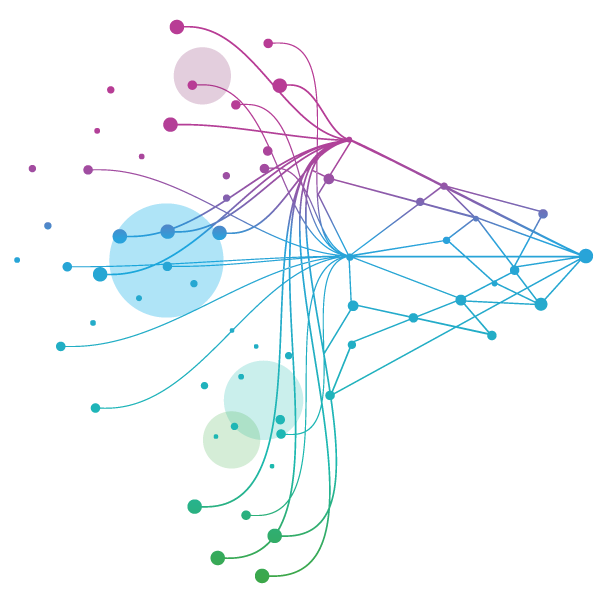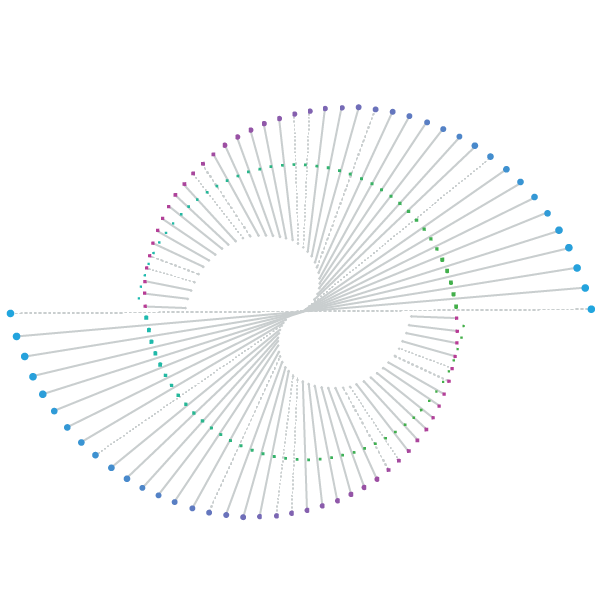





















After decades of hyper-growth, the immunology market is maturing. Intensifying competition and greater complexity weigh on future growth, however, attractive opportunities remain for those with sharp focus on unmet needs.
Immunology has long been one of the pharmaceutical industry’s most dynamic therapy areas. For over a decade, it has consistently ranked among the top three global therapy areas by value, while sustained innovation and strong commercial performance have delivered double-digit growth, year in, year out.
However, the immunology market is now entering a new phase which is defined by three trends:
- Growth slowdown: For the first time, the five-year growth outlook for immunology is expected to fall below overall pharmaceutical market growth. The autoimmune segment, once the therapy area’s growth engine, is now weighed down by biosimilar erosion. A looming immunology patent cliff in the early to mid-2030s will exacerbate this trend, as several blockbuster brands will lose exclusivity and low cost versions enter numerous, popular drug classes, e.g., IL-17, IL-23, integrin, JAK, or IL-4/13.
- Overcrowding and complexity: Major immunology indications are becoming increasingly crowded with advanced therapies. For example, over the next 3-5 years up to 24 molecules are expected to compete across 10 mechanisms of action in ulcerative colitis, with other indications facing similar levels of hyper-competition. This proliferation of therapeutic options creates complexity in treatment algorithms, makes it more difficult for new entrants to demonstrate differentiation, gives payers extensive choice, and increases the evidence burden on innovators.
- Innovation pivot: The frontier of immunology innovation is shifting. Innovators are directing their attention towards new pathways and targets, novel modalities, such as cell therapies, bi-specifics, T-cell engagers or nanobodies; oral therapies, combination therapies, smaller indications, and inflammation. These innovation efforts target unmet needs, for example, in untreated, underserved or refractory populations.
As the next chapter of the immunology market begins, innovators must adapt their playbooks.
A tale of two segments: autoimmune vs. inflammation
Immunology, as an umbrella therapy area, comprises two distinct segments - autoimmune and inflammation - each with its own, specific dynamics (see Figure 1).

The autoimmune segment, which includes, for example, rheumatoid arthritis, psoriasis, Crohn’s disease or ulcerative colitis, is becoming increasingly mature.
As discussed above, biosimilars are a drag on autoimmune growth because they introduce lower-cost versions of established therapies.
European healthcare systems in particular have become very comfortable with embracing biosimilars for cost-containment, which is reflected in ever steeper uptake trajectories with each newly launched immunology biosimilar. The most recent ustekinumab biosimilars are a case in point: They set a new record for speed of adoption in Europe, achieving 33% European share of treatment days by molecule after just two quarters on the market.
The expansion of biosimilars beyond anti-TNFs to second and third generation therapy classes, combined with a crowded innovation frontier, depresses future autoimmune growth to 4% CAGR through the end of the decade.
In contrast, inflammation, encompassing atopic, respiratory and allergy indications such as atopic dermatitis, asthma, urticaria or eosinophilic esophagitis, is emerging as the most dynamic immunology segment.
As a less mature market with higher unmet need, inflammation has been outgrowing autoimmune by a factor of 2-4x. Looking ahead, the inflammation segment is expected to maintain double-digit growth for at least the next five years, thereby outperforming both the autoimmune segment and the pharmaceutical market overall by a factor of 3x and 2x, respectively. This robust growth is supported by a rich inflammation pipeline while being protected from biosimilar exposure until the early 2030s.
Finding growth in a maturing market
Despite the slowdown in aggregate top-line growth, opportunities still exist to outgrow the overall immunology market, but it requires a more targeted approach.
Key growth opportunities manifest themselves in three areas:
- Residual unmet need
Even in well-established indications, significant sub-populations remain refractory or uncontrolled. These patients often cycle through multiple therapies without achieving sustained remission. Precision immunology - still in its early stages - offers the potential to stratify patients more effectively, tailoring treatment to individual disease drivers. Early developments in inflammatory bowel disease (IBD) suggest that biomarker-driven approaches could unlock new therapeutic strategies. - White space in smaller indications
Conditions such as Sjögren’s syndrome or prurigo nodularis represent high unmet need with currently low levels of competition. Such smaller indications are often underdiagnosed, poorly understood, and underserved by existing treatment options. The immunology pipeline is beginning to address this gap, with novel agents targeting previously un(der)-explored indications. However, success will require extensive market shaping, robust evidence generation, and navigating complex access and care pathways. - Advanced therapy-naïve patients
A surprisingly high proportion of advanced therapy-eligible patients remain untreated, often due to access barriers, resistance to injectables, or lack of awareness. In some indications, up to 90% of eligible patients may be advanced therapy naïve. This represents a significant opportunity for market expansion, particularly for therapies that offer improved convenience and/or better tolerability.
Successful innovators excel at pinpointing patient unmet need and matching it with novel, differentiated therapeutic options, which are anchored in a deep understanding of the disease biology, relevant pathways and targets.
Case example: psoriasis
Psoriasis (PsO) offers a compelling example of how innovators can unlock growth opportunities in a maturing market. Despite intense competition and a crowded treatment landscape, therapeutic options in PsO continue to evolve, with some providing innovators with a new growth runway.
The rise of next-generation oral therapies is particularly noteworthy. Historically, oral treatments for PsO have struggled to match the efficacy of biologics, limiting their use to earlier lines of therapy, typically in mild-to-moderate PsO, or to patients unwilling to pursue injectable options.
However, recent developments are changing this dynamic. Figure 2 shows how oral therapies are closing in on injectable biologics by narrowing the historical efficacy gap.

J&J’s oral IL-23 receptor inhibitor icotrokinra represents an intriguing example. This asset has emerged with best-in-class potential among novel oral therapies, delivering biologic-like efficacy with a clean safety profile, as demonstrated in the ICONIC-LEAD phase 3 trial:
By week 24, 74% of patients on icotrokinra achieved minimal or no signs of psoriasis (IGA 0/1), and 65% reached PASI 90; 46% of patients treated with icotrokinra achieved completely clear skin (IGA 0), while 40% reached PASI 100. This level of skin clearance is typically associated with leading injectable biologics of the IL-17 and IL-23 classes and positions this asset as a potential disruptor in the PsO market.
Furthermore, highly differentiated oral therapies combining convenience, biologic-like efficacy, safety and tolerability have a huge opportunity to expand the PsO market by tapping into the sizable pool of eligible, yet advanced-therapy naïve patients.
In the top seven markets, approximately 63% of eligible, moderate-to-severe PsO patients are advanced therapy naïve (see Figure 3). This treatment gap reflects a combination of factors, including access limitations, patient reluctance to initiate injectable therapies, and a lack of awareness among healthcare providers of available treatment options.
Moreover, the potential of novel oral therapies for intervention at earlier stages of PsO holds promise for altering the disease trajectory and improving long-term patient outcomes.

Despite a strong clinical rationale, market expansion into therapy-naïve patients will be met with scrutiny from payers concerned about the potential budget impact. As such, novel oral advanced therapies will face competition from low-cost advanced therapies, e.g., biosimilars or generic, oral apremilast (post Otezla LoE from 2028 onwards), which payers may mandate as first-line option in eligible, therapy-naïve patients.
Therefore, compelling evidence will be critical to make the clinical and economic case for novel oral therapies, including the real-world impact on patients’ quality of life, healthcare resource utilization, cost offsets, and long-term disease trajectory.
The evolution of oral therapies in PsO serves as a useful analogue for the broader immunology opportunity: a mature, seemingly saturated indication with entrenched competitors, yet offering growth potential for innovation carefully targeted at clearly defined unmet need.
Winning in immunology: what it takes
As the immunology market begins its next chapter, innovators must adapt their playbooks to succeed in an unforgiving environment:
- Comparative evidence: Head-to-head (H2H) trials are increasingly essential in crowded indications such as psoriasis and IBD. These H2H trials are not only about proving superiority but also enabling earlier switching from payer-mandated biosimilars to innovative therapies. In a landscape where first-line access is often restricted, evidence demonstrating unambiguous, patient-relevant differentiation becomes a critical lever. Alongside H2H trials, RWE on comparative effectiveness and safety in routine practice plays an equally important role.
- Commercial precision: Immunology is one of the most fiercely competitive markets, with total global promotional investment exceeding $7bn in 2025. Perpetuating this share of voice arms race is not a viable strategy for the future, as HCPs hit noise saturation. Instead, investment must be targeted at discrete pockets of value, defined by the intersection of patient sub-populations with the highest unmet need and relevant HCP segments who treat them. This becomes even more important as innovation increasingly targets smaller, less mature indications and patient sub-segments.
- Advocacy and medical engagement: Successful adoption of novel therapies entering a crowded treatment landscape requires early advocacy building to help shape guidelines and enable HCPs to navigate increasingly complex treatment algorithms. Smaller immunology indications present unique challenges, such as low disease awareness among patients and healthcare professionals, including the burden of illness, and immature care pathways. For both scenarios, early investment in medical affairs-led external engagement is key.
- Patient support excellence: Patient support programmes remain a critical differentiator. By investing in personalised patient engagement, nurse-led services, and digital tools, companies can improve adherence, reduce abandonment, and enhance patient outcomes. These programmes also offer a valuable source of real-world evidence and patient insight. In a market where treatment persistence, durable remission and quality of life are increasingly important metrics, patient support is elevated to a strategic imperative.
- Permanent launch mode: Many immunology therapies have multi-indication potential as they target universal pathways underlying several diseases. Rapid indication expansion has been the hallmark of mega-blockbuster brands, e.g., Humira, Stelara, Dupixent, or Skyrizi, which requires close alignment between clinical, medical, and commercial teams. A particular challenge faced by innovators with multi-indication assets is maintaining organisational focus to successfully deliver multiple indication launches, often in close succession.
Final thoughts
As immunology’s golden age of hyper-growth across the board is drawing to a close, opportunities for innovators still remain, however, they will require a different approach. The next chapter for capturing growth in immunology will be defined by a sharp, relentless focus on unmet needs to guide carefully targeted innovation and shape patient-relevant differentiation.





